Islamic art, while including representational images, is highly developed as a decorative art. Their design and use of tilings developed into a very sophisticated form of art over thousands of years. The artisans who developed the tilings worked with mathematicians both to develop new designs and also efficient ways to produce them.
The Persian mathematician Abu’l Wefa (940 to 998) wrote a book describing the discussions that took place.
Islamic patterns as new tiles from old
This is a common Islamic pattern. It is derived from a visual proof of Pythagoras’ Theorem by Abu’l Wefa.

The steps to creating the motif are as follows:
 1. Take a square and join corners to the mid-points of the sides as here.
1. Take a square and join corners to the mid-points of the sides as here.
2. Rub out part of the lines to make right angled triangles.
This motif is chiral (it exists in right and left-handed forms) so the design is now created by successive reflections. Thus four together look like this (the blue lines show the lines of symmetry):
 If a square tile is made up from reflections of the original motif (as above), then it can be used to build up the pattern.
If a square tile is made up from reflections of the original motif (as above), then it can be used to build up the pattern.
Investigation
Using the following version of the motif:

1. What is the area of the square in the centre if the large square has side one unit?
2. Why do the lines forming the central square intersect on the circles?
Some more motifs in Islamic tilings
The above motif can be modified in many ways. For example, the red lines show how to construct one of the most common islamic tilings.

Using successive reflections of the red tile above, the pattern can be built up as below:
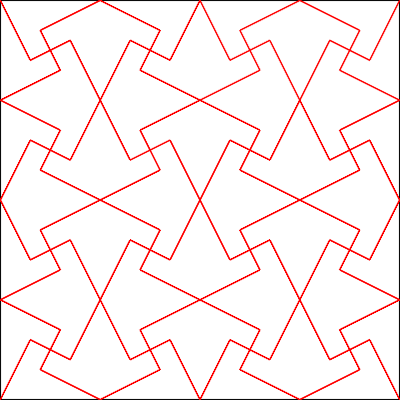 A slightly different motif:
A slightly different motif:
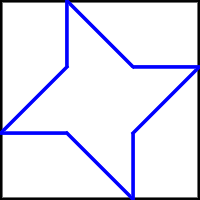 makes this pattern when reflected:
makes this pattern when reflected:
Can you see how it is tiled to create the pattern? This pattern is often found in tiling pavements. One of the most famous examples of this pattern can be seen at the Taj Mahal in India.
Morphing Islamic Tilings
There are many ways to morph Islamic patterns. The following set of morphings is based on one of the motifs that we have seen before. The central square increases from a point until it becomes the square that is the size of the tile itself:
 The following three tilings are all based on this morphed set.
The following three tilings are all based on this morphed set.



What is the difference between them?
Which is most like the original tiling?
What types of symmetry are there?
The Taj Mahal pavement tile can be morphed from the original star shape to an irregular octagon:

This then gives a morphed tiling like this:

What other types of tilings can you make?
Morphing Stellated Islamic Patterns
Many Islamic patterns are “stellated”. These star shaped designs are often said to have arisen since the mathematicians working with the artisans were astronomers as well. The following method for creating a stellated pattern is ideal for morphing.
Step 1 – Make a triangular grid.
 Step 2 – Draw circles at the intersections of the grid. The radius of the circle does not matter but they should all be the same.
Step 2 – Draw circles at the intersections of the grid. The radius of the circle does not matter but they should all be the same.
 Step 3 – Divide the circumference of the circle into twelve.
Step 3 – Divide the circumference of the circle into twelve.
 Step 4 – Join points in a star shape like this:
Step 4 – Join points in a star shape like this:
 Step 5 – Do this for all the circles and then rub out the construction lines.
Step 5 – Do this for all the circles and then rub out the construction lines.

Here is the stellated pattern above coloured in:
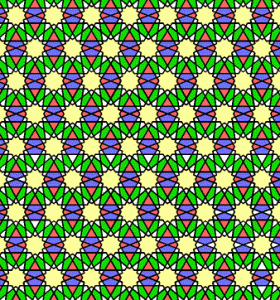
Can you see sets of overlapping hexagons?
What other closed polygons are there?
Morphing the designs
To change the design change the radius of the circle:

When you enlarge the radius, the central “hole” gets larger and gives a lace effect:
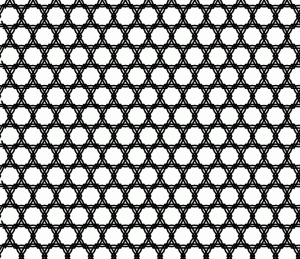
But making it a lot larger causes overlaps and the “hole” gets smaller again.

The following magnified part of this design shows it is unlike anything in normal Islamic art and almost looks like basket weaving:
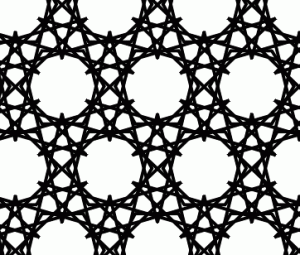
Systematically varying the size of the circle on the same grid, gives a tiling that morphs as it goes down the image:
Investigations
The picture below uses a rhombic grid and only divides the circle into six points:
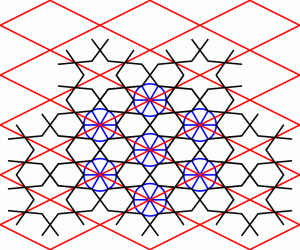
Investigate making morphing tilings with this system.
The diagonals of each rhombus are in the ratio of 1:2. Investigate the morphing affect of changing the shape of the rhombus.



I realy like the patterns, can you tell me what is the relationship of weaving with islam???
I am not sure in which sense you mean weaving. I don’t know anything about textile weaving in this respect, but in a mathematical sense there is a link.
Islamic art has many examples of weavng in tilings which is known as interlacing.
There is a good set of examples at http://gwydir.demon.co.uk/jo/knots/islamic.htm showing how it is a part of knot theory in topology. There have been many papers written on this.
Hope that helps
John S
I wish geometry at school had been like this. It’s creative and beautiful presented this way. Many thanks for the instruction.